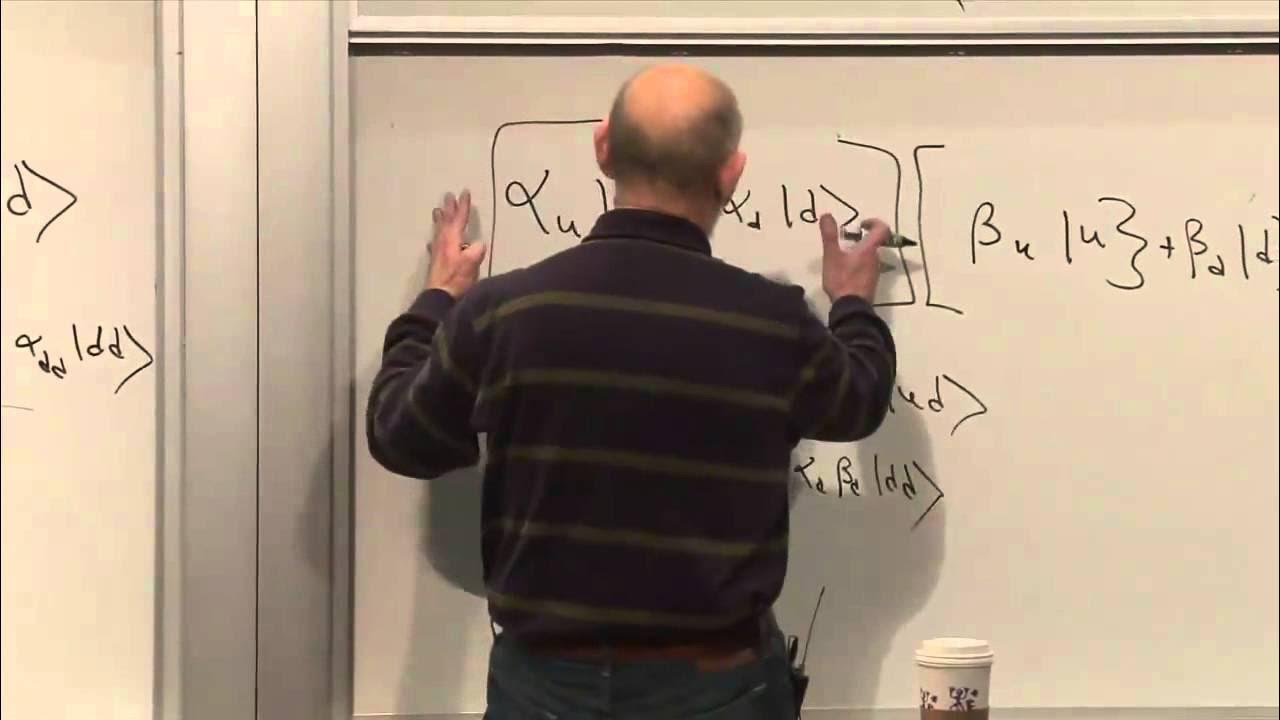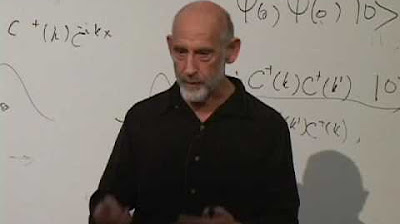Statistical Mechanics Lecture 9
TLDRThe video script is a detailed lecture on the Ising model, a mathematical model of ferromagnetism in statistical mechanics. The lecturer corrects a previous misunderstanding about the Ising model's solutions and phase transitions, emphasizing that the one-dimensional Ising model lacks a phase transition, but higher dimensions do exhibit such behavior. The explanation delves into the concept of phase transition as a sudden change in system properties, such as magnetization, in response to temperature changes. The lecture also uses an approximation method to demonstrate that in high dimensions, the system tends to align in a magnetic field, indicative of a phase transition. The content is rich with analogies, such as comparing the model's behavior to a game of telephone, to illustrate the propagation of spin states through a lattice. The script is both educational and engaging, providing insights into the complexities of statistical mechanics and the behavior of magnetic systems.
Takeaways
- 🧲 The Ising model is a mathematical model of ferromagnetism in statistical mechanics, which describes the behavior of a lattice of interacting spins.
- 📉 At high temperatures, the Ising model shows no net magnetization, indicating a random arrangement of spins.
- 📈 As the temperature decreases, the model undergoes a phase transition where spins start to align, leading to a net magnetization.
- 🔄 The concept of 'duality' is introduced, showing that different systems can be equivalent under certain transformations, which is a significant concept in modern physics.
- 🔩 The mean field approximation is used to simplify the calculation of interactions in the Ising model, particularly in high dimensions.
- ⏱️ At absolute zero temperature, all spins align, which is a stable state known as the ground state of the system.
- 🔢 The number of dimensions (D) in the Ising model affects its behavior, with higher dimensions leading to more stable magnetization due to the increased number of interactions.
- 🤔 The one-dimensional Ising model lacks a phase transition and does not exhibit spontaneous magnetization, unlike higher-dimensional models.
- ⚖️ The introduction of even a tiny external magnetic field can stabilize the magnetization direction in the Ising model, illustrating the concept of spontaneous symmetry breaking.
- 📌 The average spin in the model is calculated using the hyperbolic tangent function, which relates the spin alignment to the temperature and interaction strength.
- 🌐 In high dimensions, the interactions between spins are more robust, leading to a system where errors in spin alignment are corrected, similar to error correction in digital communication.
Q & A
What was the speaker's initial misunderstanding about the Ising model?
-The speaker initially thought that Ising failed to solve the model correctly or that there was a phase transition in the one-dimensional model, but later corrected himself, stating that Ising did solve the one-dimensional model correctly and realized there was no phase transition in that specific case.
What is a phase transition in the context of the Ising model?
-A phase transition in the Ising model refers to a sudden change in the properties of the system, such as magnetization, as a parameter like temperature is varied.
How does the energy of a single spin in the Ising model relate to its 'up' or 'down' state?
-The energy of a single spin is determined by the magnetic moment times the magnetic field, with a variable called Sigma representing the 'up' or 'down' state. If Sigma is positive ('up'), the energy is negative, and if Sigma is negative ('down'), the energy is positive. Lower energy states are favored, especially at low temperatures.
What is the significance of the hyperbolic tangent function in the context of the Ising model?
-The hyperbolic tangent function describes the average energy and magnetization of a spin in the Ising model as a function of the inverse temperature times the interaction strength (beta times J). It shows how the system's behavior changes with temperature.
What is the role of the mean field approximation in understanding the Ising model in high dimensions?
-The mean field approximation simplifies the problem by assuming that each spin experiences an average magnetic field created by its neighbors. This approximation becomes more accurate as the number of dimensions (D) increases, allowing for insights into the behavior of the system in high-dimensional spaces.
Why does the one-dimensional Ising model not exhibit a phase transition?
-The one-dimensional Ising model does not exhibit a phase transition because the correlations between spins decay exponentially with distance, meaning that the influence of a spin on others diminishes rapidly, preventing a long-range order.
What is the concept of 'error correction' in the context of the speaker's analogy of the game of telephone?
-In the context of the game of telephone, error correction refers to the idea that if a message is passed along with some errors, but most of the recipients receive the correct message, they can collectively determine the most likely correct message, thus correcting the errors.
How does the number of dimensions affect the behavior of the Ising model?
-As the number of dimensions increases, each spin has more neighbors, which can lead to a situation where the majority vote (error correction) results in the correct spin orientation being maintained. This can lead to a phase transition where the system exhibits long-range order, even at finite temperatures.
What is the self-consistent field approximation and why is it used in the Ising model?
-The self-consistent field approximation is a method used in statistical mechanics where each spin is assumed to be influenced by an average magnetic field created by all other spins. It is used because it allows for a tractable calculation of the average spin in a system, especially useful when dealing with large numbers of dimensions or neighbors.
Why does adding a small magnetic field to the Ising model result in a preference for one spin direction over the other?
-Adding a small magnetic field to the Ising model introduces an energy bias that favors one spin direction over the other. Even if the field is very small, the large number of spins can result in a significant overall energy difference, leading to a preference for alignment in the direction of the magnetic field.
What is the significance of the Earth's magnetic field in relation to the Ising model?
-The Earth's magnetic field, while not directly related to the Ising model, serves as a real-world example of how a small magnetic field can influence the orientation of a system (like a compass needle). It illustrates the concept of spontaneous magnetization and symmetry breaking in the context of the Ising model.
Outlines
😀 Introduction to the Ising Model and Phase Transitions
The speaker begins by addressing a previous misunderstanding about the Ising model, clarifying that Ising did solve the one-dimensional model correctly but erred in assuming no phase transition exists in any dimension. The lecture aims to explore phase transitions in the Ising model, particularly in higher dimensions, using an approximation method. The concept of phase transition as a sudden change in system properties, notably with temperature variation, is introduced. The simple example of a collection of magnets with an energy function based on their 'up' or 'down' state is revisited, and the notation is simplified using the variable Sigma and the product J.
🔍 Deep Dive into the Partition Function and Energy Calculation
The paragraph focuses on calculating the partition function for a single spin, which is simplified by considering the system's independence. The partition function is expressed as a hyperbolic cosine function of beta times J. The energy of a single spin is derived, and the concept of averaging the energy is discussed. The probability of a spin being up or down is also explored, leading to the introduction of the hyperbolic tangent function as a descriptor of the spin's average state.
🧲 Examining the One-Dimensional Ising Model
The discussion shifts to the one-dimensional Ising model, where the energy depends on neighboring spins. The total energy is the sum of products of neighboring spins, each multiplied by a constant J. The ground state of the system is explored, revealing two possible configurations with all spins aligned 'up' or 'down'. The impact of changing the sign of J is also considered, showing that the system remains mathematically identical despite appearing different.
🔗 Correlation Functions and Conditional Probabilities
The concept of correlation functions is introduced to measure the influence one spin has on another further down the chain. The speaker uses the analogy of a game of telephone to illustrate how the signal or influence of a spin being up can propagate through the system. The importance of the partition function in calculating these probabilities is emphasized, and the challenge of summing over all possible configurations is acknowledged.
🔄 The Role of Memory in Spin Influence and Propagation
The speaker discusses the diagnostic value of the average product of spins at different locations to understand the influence of one spin on another and its propagation through the system. The game of telephone analogy is revisited to explain how memory or influence fades with distance. The concept of 'memory' in the context of a spin's influence on its neighbors is explored, and the mathematical implications of this fading influence are detailed.
🎭 The Trick of Focusing on Links Between Spins
A strategic approach to understanding the Ising model is presented, which involves focusing on the links between spins rather than the spins themselves. This approach simplifies the partition function and allows for a clearer understanding of the energy associated with the bonds between neighboring spins. The speaker also introduces the concept of bond variables and how they can be used to express the partition function.
🔮 Mean Field Approximation and Phase Transitions
The mean field approximation is introduced as a method to analyze the Ising model in high dimensions. The approximation assumes that each spin is influenced by a field created by its many neighbors, leading to a self-consistent field approximation. The speaker derives an equation for the average spin and discusses how this approximation can predict a phase transition at high temperatures, where the system exhibits magnetization.
🧲 The Phenomenon of Magnetization and Phase Transition
The speaker explains the phenomenon of magnetization in the context of the Ising model, highlighting it as a phase transition where the system develops a net magnetization. The role of temperature in this transition is discussed, with the system exhibiting random behavior at high temperatures and a preference for alignment at lower temperatures. The speaker also touches on the implications of adding a small magnetic field to the system.
🌐 The Behavior of the Ising Model in Higher Dimensions
The discussion shifts to the behavior of the Ising model in higher dimensions, with the speaker explaining that the model behaves differently in two dimensions compared to one. The concept of dimensional dependence is explored, and the speaker suggests that the model's behavior in high dimensions can be understood through approximations and limits, even if it cannot be solved directly.
🔧 The Calculation of Energy Costs in Spin Flipping
The energy costs associated with flipping spins in the Ising model are calculated, with comparisons made between one-dimensional and two-dimensional cases. The speaker illustrates how the number of broken bonds and the resulting increase in energy depend on the number of flipped spins and the dimensionality of the system. The stability of the system with respect to spin flipping is also discussed.
🌌 Conclusion and Further Exploration of Magnets
The speaker concludes the discussion by acknowledging the complexity of the Ising model and the richness of its implications for understanding magnetism. They express an intention to continue exploring topics related to magnets and possibly metals in future lectures. The speaker also invites the audience to visit Stanford.edu for more information.
Mindmap
Keywords
💡Ising Model
💡Phase Transition
💡Magnetic Moment
💡Partition Function
💡Magnetization
💡Correlation Function
💡Mean Field Approximation
💡Ferromagnetism
💡Temperature
💡Statistical Mechanics
💡Duality
Highlights
The speaker corrects a previous misconception about the Ising model, emphasizing that it was solved correctly by its creator.
The one-dimensional Ising model was solved correctly, but the assumption that it lacked a phase transition was incorrect.
An approximation method is introduced to study phase transitions in higher dimensions of the Ising model.
The concept of a phase transition is explained as a sudden change in a system's properties, such as temperature.
The energy function of a single magnet is discussed, highlighting the relationship between spin direction and energy.
The partition function for a single spin is derived, simplifying the calculation of the system's energy.
The average energy and magnetization of a spin are calculated using the hyperbolic tangent function.
The behavior of the Ising model at low and high temperatures is analyzed, showing how spin orientation changes.
The speaker uses the analogy of a game of telephone to explain the propagation of spin states through the system.
The concept of correlation functions is introduced to measure the influence of one spin's state on another, distant spin.
The Ising model's energy is expressed as a sum over neighboring spins, leading to a simplification in calculation.
The mean field approximation is applied to the Ising model in high dimensions, predicting a phase transition.
The speaker discusses the physical implications of the Ising model in two and three dimensions, relating it to real-world magnets.
A self-consistent field approximation is used to derive an implicit equation for the average spin in the system.
The conditions for a phase transition in the Ising model are explored, showing how it depends on temperature and dimension.
The impact of an external magnetic field, no matter how small, on the stability of the Ising model's magnetization is discussed.
The speaker concludes that the one-dimensional Ising model is unique in not exhibiting a phase transition, unlike higher dimensions.
Transcripts
Browse More Related Video

Lecture 5 | The Theoretical Minimum

Lecture 6 | The Theoretical Minimum

Percolation: a Mathematical Phase Transition

Could One Physics Theory Unlock the Mysteries of the Brain?

Lecture 5 | New Revolutions in Particle Physics: Basic Concepts

Phase Diagrams | Phase Diagram of Water and Phase Diagram of Carbon Dioxide
5.0 / 5 (0 votes)
Thanks for rating: